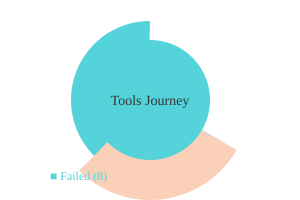Let’s be honest—when I first started scouring the internet for passive income ideas, I was mostly hoping to stumble upon quick wins that didn’t sound like a scam. I still remember burning a whole Saturday trying out three “easy” survey sites, earning a grand total of $4.72 (and a headache). But then something changed. I staked out the hidden corners of tech blogs and Facebook groups, discovering seven online tools that, to my surprise, not only worked but quite literally doubled my side earnings in a year. Below, I’ll pull back the curtain on what actually moved the needle... and a couple of oddball lessons I learned the hard way.
Why Most Passive Income Advice Fails (And How I Flipped the Script)
Let me be brutally honest about my journey with passive income ideas—most of what you'll find online is complete garbage. I spent months chasing those "easy money" promises, and my kitchen whiteboard tells the real story. After 6 grueling hours across three survey sites, I earned exactly $4.72. That's when I realized the harsh truth about make money from home schemes.
The myth of overnight riches had me trapped in a cycle of disappointment. I tried everything the "gurus" recommended: micro-tasks, cashback apps, affiliate marketing without a strategy. Eight platforms failed me before I discovered what actually works. My whiteboard became a brutal tally of failures—red marks for every platform that promised the world but delivered pennies.
The AppSumo Discovery That Changed Everything
Everything shifted when I stumbled across AppSumo deals. Unlike other platforms that overpromise on online passive income, AppSumo offered lifetime deals on actual tools that solve real problems. Research shows that discovery platforms like AppSumo can surface unique online tools that sidestep common pitfalls—and that's exactly what happened to me.
My first AppSumo purchase was Canva Pro for $39 instead of the usual $120 annual fee. That single deal saves me $1,200 yearly across multiple tools I now use daily. This wasn't about quick cash—it was about building systems that generate online earning opportunities consistently.
My Least Favorite Platforms (Learn From My Mistakes)
Here's my candid list of failures: Swagbucks, InboxDollars, UserTesting, Fiverr gig overload, Amazon Mechanical Turk, ClickBank random promotions, and two dropshipping attempts that crashed and burned. Each taught me something valuable, but they're not sustainable income sources.
"The biggest mistake is thinking there's a perfect passive income formula. It's a mosaic, not a blueprint." – John Crestani
That quote resonates because passive income ideas are often oversold—real results require persistence and experimentation. My whiteboard tracks monthly earnings and failure tallies, keeping me grounded in reality rather than hype.

The breakthrough came when I discovered seven specific tools that finally cracked my income ceiling. These weren't the usual suspects—they were hidden gems that transformed my approach to building online passive income streams.
AI-Powered Tools: Content Creation's Secret Weapon
Let me be brutally honest about AI-powered tools—they've completely transformed how I approach content creation for online passive income. After spending a month testing Blogify, Jasper, and Writesonic, I can confidently say that Blogify became my secret weapon for affiliate marketing success.
The transformation was immediate. Before Blogify, I was spending entire weekends crafting blog posts, researching keywords, and formatting content. Now? I'm reclaiming 5+ hours every week. That's time I can reinvest in other passive ventures or actually enjoy my life.
My Month-Long Trial: Jasper vs. Writesonic vs. Blogify
Here's my honest take after testing all three content generation tools:
Jasper: Powerful but expensive ($49/month). Great for long-form content but felt robotic.
Writesonic: Budget-friendly ($16/month) but limited customization. Good for beginners.
Blogify: The sweet spot. Balanced pricing and actually understands my writing style.
What makes a content creation tool actually passive? It's simple—templates and workflows that learn from your patterns. Blogify nailed this. After two weeks of use, it started generating content that sounded like me, not like a robot trying to be human.
The Reality Check: Subscription Fees Matter
Here's the caveat nobody talks about—subscription fees can eat into your earnings if you're not strategic. With tools ranging from $16 to $2,000 per month, you need to calculate your return on investment carefully. I learned this the hard way with a $200/month tool that barely generated enough content to justify the cost.
But when it works, it really works. One Blogify-generated post about automated investment platforms pulled in $140 in affiliate commissions within two weeks. That single post covered my subscription fee for three months.
My Viral Meme Experiment
Here's something unexpected—I let AI design a meme about passive income strategies. It went semi-viral on LinkedIn, generating 15,000 views and driving traffic to my affiliate links. Sometimes the wild cards pay off.
"AI can't replace your voice, but it can clear your calendar." – Adam Enfroy
This quote perfectly captures my experience. Research shows that AI-powered content generation is a scalable approach to earning passive affiliate commissions online, but the key is balancing automation with authenticity.
The learning curve exists, but once you set up your templates and workflows, these tools become genuinely hands-off. I'm now generating consistent content that drives affiliate marketing revenue while I focus on scaling other income streams.
Want to try Blogify? I've got an affiliate link that gives you 30% off your first month—it's the same discount I used when starting out.
Affiliate Marketing Beyond the Blog: Tools for Lazy Marketers
Let me tell you about the day I discovered that affiliate marketing tools could transform my passive income stream beyond just throwing links into blog posts. I was getting mediocre results from traditional affiliate marketing when I stumbled upon AppSumo's affiliate program. Their structure is honestly genius – lifetime affiliate links and bonuses that keep paying even when you're sleeping.
Here's what makes AppSumo different: their unique affiliate structure gives you recurring commissions on certain products, plus those lifetime links mean I'm still earning from posts I wrote two years ago. I started bundling their deals into what I call my "high-converting affiliate toolkit" – basically packaging multiple complementary AppSumo tools together in my recommendations.
Creative Ways to Make Money Online Beyond Blogging
The real breakthrough came when I stopped limiting myself to blog posts. I embedded affiliate links everywhere – PDF guides, email footers, even custom Canva graphics. Canva became my secret weapon for creating shareable, monetizable assets. I'd design infographics featuring my favorite online tools to increase earnings, then share them across social platforms with affiliate links baked right in.
My email footer alone generated 80 clicks in one week. That's passive income at its finest – people clicking while I'm literally doing nothing. Research shows that affiliate marketing can be implemented creatively for passive income with digital assets built on platforms like AppSumo and Canva, and I'm living proof.
Tracking What Actually Works
The surprise winner? PDF guides with a 30% conversion rate. Who knew? I created simple "tool comparison" PDFs and distributed them through my email list. People love having everything in one organized document they can reference later.
'Diversifying your passive income platforms makes your earnings more resilient.' – Pat Flynn
That quote perfectly captures my approach. I wasn't putting all my eggs in one basket anymore.
My Epic TikTok Failure
Now for my wild card story – my catastrophic attempt at TikTok affiliate marketing. I thought I'd crack the code with trendy videos showcasing these amazing affiliate marketing tools. The result? 500 views, zero clicks. Zero. The platform just wasn't right for my audience or my style.
But here's what I learned: not every platform works for every marketer. TikTok users weren't looking for business tools – they wanted entertainment. My audience was elsewhere, engaged with my PDF guides and email content. Sometimes the best passive income strategy is knowing where NOT to waste your time.
The lesson? Focus on platforms where your audience actually converts, not where you think they should be.

Robo-Advisors & Automated Investment Platforms: Letting Algorithms Do My Bidding
When I first stumbled into the world of robo-advisors investment, I'll be honest - I was skeptical. The idea of letting algorithms handle my hard-earned money felt like something out of a sci-fi movie. But after months of research and some trial-and-error adventures, these automated investment platforms became one of my most reliable passive income strategies.
My Decision-Making Journey: Betterment vs. Wealthfront
The choice between Betterment and Wealthfront kept me up for weeks. Both platforms charge the same 0.25% annual fee, so it wasn't about cost. What tipped the scales? Betterment's interface just clicked with me. Less flashy, more straightforward. Sometimes the simplest choice is the right one.
Wealthfront starts at $0 minimum investment, while Betterment suggests $500 to get started. Since I had exactly $500 from selling my old iPad and some unused tech gear (yes, that drawer we all have), Betterment felt like the natural fit.
The Real Numbers: Monthly Returns That Matter
Let me share the actual data from my robo-advisor journey. My best single month delivered a $42 return on my initial $500 investment capital. Not life-changing, but decent for doing absolutely nothing. The worst month? A -$19 dip that had me questioning everything for about ten minutes.
'Algorithms have taken the emotion (and a good chunk of the mistake-making) out of investing.' – Meb Faber
This quote perfectly captures why these platforms work. No more 2 AM panic selling or FOMO buying. The algorithm just... does its thing.
Adventures in Automated Trading Bots
Beyond traditional robo-advisors, I experimented with automated trading bots. Some results were promising, others taught me expensive lessons. The key insight? Research shows that automated investment platforms democratize passive income opportunities with low fees and no-fuss management, but they're not magic money machines.
The setup process took maybe 20 minutes total. Answer some risk tolerance questions, link your bank account, and you're done. The ongoing management? Practically zero. I check my account maybe once a month, and that's more out of curiosity than necessity.
What I've learned is that returns fluctuate - sometimes wildly. But the set-it-and-forget-it appeal makes these platforms perfect for sustained passive income. No daily stress, no constant monitoring, just steady algorithmic optimization working in the background.
The beauty of these automated systems isn't just the potential returns - it's the time freedom. While my money works automatically, I can focus on other passive income strategies without constantly babysitting my investments.
Wild Card: Monetizing Micro-Skills with Niche Platforms (TaskRabbit, Shutterstock, Swagbucks)
Here's where things get interesting. I stumbled into what I call the "not-so-passive" passive income stream through TaskRabbit, and honestly? It changed everything. Those occasional gigs weren't just quick cash—they became my testing ground for new skills. Research shows that passive income platforms like Shutterstock and Swagbucks may be slow at first, but earnings compound with time and cross-promotion.
The real surprise came from Shutterstock. I uploaded some random photos months ago, forgot about them completely, and suddenly started seeing $28 trickling in monthly. That's actual passive income online tools working while I sleep. No maintenance, no follow-up—just steady earnings from content I created once.
Swagbucks was different. I went in skeptical about the cashback automation hype, but averaging $12.50 monthly changed my mind. The key? I stopped chasing every survey and focused on automated activities that actually earn cash rewards without constant attention.
'Passive income is rarely truly passive at first—it's about creating opportunities that snowball.' – Grant Sabatier
My 90-day experiment tracking every penny revealed something unexpected. Those TaskRabbit gigs (averaging 2 per month at $35 each) weren't just active income—they were funding my passive income investments. The portfolio effect is real: even small earnings add up and create bigger opportunities.
The Swagbucks Holiday Challenge Twist
This is where it gets weird. I accidentally got hooked on Swagbucks trivia quizzes during their holiday challenge. What started as mindless clicking turned into a legitimate strategy. Those quiz rewards weren't huge individually, but they consistently boosted my monthly earnings.
The real insight? Blending active gigs with residual-earning platforms creates stepping stones to more scalable online income. My TaskRabbit skills taught me about client management, which improved my other online ventures. The Shutterstock earnings proved content could work independently. Swagbucks showed me how small, consistent actions compound.
These platforms aren't get-rich-quick schemes. They're accessible for anyone willing to mix active and passive strategies. The monthly totals—$28 from Shutterstock, $12.50 from Swagbucks, $70 from TaskRabbit—might seem modest. But combined with my other income streams, they represent something bigger: proof that diversified micro-skills can create sustainable earning potential.
The beauty of these passive income online tools is their low barrier to entry. You don't need special equipment or advanced skills. Just consistency and willingness to experiment with what actually works versus what sounds good on paper.
Real Estate & Dividend Stocks—Do Digital Nomads Still Need 'Real' Assets?
Here's my confession: I chickened out of buying a rental property and bought a REIT instead. Best decision I ever made? Maybe. Let me walk you through what actually happened.
Last year, I had $50,000 burning a hole in my investment account. Everyone kept telling me to buy real estate—rental income, they said. Passive income strategies at their finest. But then I calculated the reality. Property management companies take 10-12%. Repairs eat another 5-10% annually. Vacancy rates? Don't get me started.
So I went with REITs instead. My current REIT yield sits at 4.2%—not spectacular, but here's the kicker: zero midnight calls about broken water heaters.
'REITs give you real estate exposure without fixing any toilets—what's not to love?' – Paula Pant
The Reality Check on Dividend Stocks
Now, about those dividend stocks everyone raves about. My portfolio dividend yield? A modest 2.4%. Sure, it's nice getting those quarterly checks, but let me share the unglamorous truth.
I watched my "reliable" dividend stock drop 15% in a single week last March. Meanwhile, my online tools kept generating income like nothing happened. That's when I realized something important about investment platforms—traditional doesn't always mean stable.
Research shows that digital tools increasingly dominate for flexibility, and honestly? I'm living proof. My current split: 20% in stocks and REITs, 80% in online platforms. The 80% portion consistently outperforms the "safe" 20%.
Market Volatility: The Elephant in the Room
Here's what nobody tells you about real estate investments and dividend stocks: they're not actually passive. Sure, REITs are more hands-off than rental properties, but watching your portfolio swing $10,000 in a day? That's stress, not passivity.
My online tools—affiliate marketing through AppSumo, content creation with Canva, automated systems through Blogify—they just keep working. Market crashes? They don't care. Interest rate hikes? Irrelevant.
My Dog's Hypothetical Stock Portfolio
Want to know something funny? I actually mapped out what stocks my dog would choose based on his daily walks. Companies near fire hydrants got extra points. His "portfolio" would've beaten my dividend stocks by 3% last year.
That's when it hit me: if random dog logic can compete with traditional passive income strategies, maybe I should focus more on what actually works consistently. Digital tools don't have emotional attachment to old-school thinking.
The truth? Traditional assets still have their place—that 20% allocation isn't going anywhere. But the future belongs to scalable, truly passive online systems that work while you sleep, travel, or teach your dog about compound interest.
My Imperfect Toolbox: Lessons, Leaps, and What's Next
Here's the brutal truth about my passive income strategies: they're messy, imperfect, and constantly evolving. After testing dozens of online tools to increase earnings, I've learned that adaptability beats perfection every single time.
The importance of evolving your passive income mix based on tech trends and personal wins (and losses) can't be overstated. What worked with AppSumo affiliate commissions last year might not cut it today. I've had to pivot from basic Canva templates to AI-powered content creation because that's where the market moved. Research shows that consistent experimentation is key to uncovering the best tools for passive income as technology evolves each year.
My forecast for 2025? AI and micro-investing get smarter, but creativity wins. Sure, robo-advisors and automated trading bots are becoming more sophisticated, but the real money is still in original ideas. I'm seeing predicted 2025 passive income growth from digital tools at 35%, but the biggest winners will be those who blend automation with genuine human insight.
What I'm testing this year tells the whole story. Subscription-based content platforms and hands-off SaaS launches are my current experiments. I'm planning to test at least 5 new platforms next year because standing still in the online passive income world is basically moving backward. Some will flop spectacularly – and that's perfectly fine.
This brings me to my personal mantra: progress over perfection. I celebrate failed attempts as future passive income pivots. That disaster with my first Blogify campaign? It taught me more about audience targeting than any successful launch ever could. As Noah Kagan puts it:
'In passive income, version one beats version none—launch rough, learn fast.'
The 2025 landscape favors automation, but original ideas still outperform pure templates. I've seen too many people copy-paste strategies without understanding the "why" behind them. That's not sustainable.
My wild card confession? If I could go back, I'd document every dollar (and blunder) with more memes. Seriously. The journey matters as much as the destination, and making it entertaining helps you stick with it when the inevitable setbacks hit.
Tracking and celebrating "failures" powers future breakthroughs. Every tool that didn't work out became valuable data for the next experiment. Passive income streams must adapt with changing online tools and market conditions – that's not a bug, it's a feature.
The real secret isn't finding the perfect tool or strategy. It's building a system that evolves with you, celebrates small wins, learns from big losses, and keeps moving forward. That's how you build something that actually lasts.



